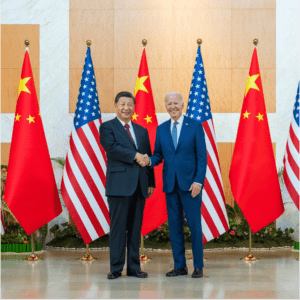19 year-old Maciej Cebula compares Trump’s and Biden’s strategies on US-China relations, focusing on trade, military, technology, and Asia-Pacific diplomacy

November 14, 2022. US President Joe Biden (R) meets with Chinese leader Xi Jinping before the 17th G20 in Bali.
July 16, 2024
Navigating the US-China rivalry: Trump and Biden’s divergent strategies in the Asia-Pacific region
As the 2024 presidential elections in the United States approach, the issue of the US relations with China has taken centre stage in public discourse.
The debates between candidates Joe Biden and Donald Trump have frequently touched on their respective approaches to managing rivalry with China. This focus underscores the increasing prominence of US-China relations in American political and strategic thinking.
Both candidates have articulated their positions, reflecting broader concerns about trade deficits, military posturing, and technological competition.
The trade deficit and tariffs
The trade deficit with China has been a longstanding concern, particularly during Trump’s presidency between 2017-2021. Trump’s administration sought to address the imbalance through a series of tariffs, marking the beginning of a trade war that significantly impacted global trade dynamics.
In January 2018, Trump imposed tariffs on solar panels and washing machines, escalating to include a wide range of goods, including raw materials like aluminium, high-tech products such as semiconductors and agricultural products like vegetables.
Economists criticised this approach, arguing that the trade deficit was more of a result of microeconomic factors than trade policies. Despite these critiques, the tariffs remained, reflecting a broader strategy to curb China’s economic influence. By the end of Trump’s term, the trade deficit with China had decreased somewhat but the overall US deficit increased, indicating mixed results for the tariff strategy.
The Biden administration, upon taking office in January 2021, chose to maintain these tariffs, despite the calls from the World Trade Organization (WTO) to end them, signalling a bipartisan consensus on the need to confront China’s economic practices. Biden’s administration also introduced additional measures, such as the CHIPS Act, aimed at bolstering domestic semiconductor production and reducing dependency on Chinese imports. This act represents a significant investment in the US technological infrastructure, crucial for maintaining competitive advantage in advanced technologies.
“We are the lowest trade deficit with China since 2010 […] under this guy,” Biden said during the presidential debate on June 27.
Both sides of the race have proposed tariffs on Chinese imports. In February 2024, Trump announced a potential 60% tariff plan for Chinese imports if he wins a second term. In May, the Biden Administration implemented a 100% tariff on all Chinese-made electric vehicles, citing the need to protect American businesses and workers, combat China’s unfair trading practices, and address China’s control over critical components used by the US manufacturers.
Bilateral relations and regional diplomacy
Both Trump and Biden have engaged actively in East Asia and the Western Pacific, their approaches differ significantly. Trump’s tenure saw a historic bilateral meeting with North Korea’s Kim Jong-Un, highlighting his unconventional and personal style of diplomacy.
These meetings, though ground-breaking, yielded limited substantive progress on nuclear disarmament. The US aims in the context of alliances under Trump were also focused differently to Biden’s, demanding from allies like South Korea and Japan to contribute more to their own security and to the upkeep of US forces in their territory.
In contrast, Biden has focused more on strengthening alliances through multilateral initiatives. AUKUS, a security pact with the United Kingdom and Australia, shows this approach and aims to strengthen the region and introduce advanced defence systems in Australia. Additionally, the JAROKUS, a trilateral pact with Japan and South Korea, underscores Biden’s commitment to a collective security architecture in the region.
These diplomatic efforts are part of a broader strategy to counter China’s influence. The US aims to reinforce its alliances and enhance the defence capabilities of its partners.
This approach reflects a shift towards a more collaborative strategy while dealing with regional challenges.
Taiwan: the flashpoint
Taiwan remains a focal point of US-China tensions. Biden has declared multiple times that the US would support Taiwan against Chinese aggression, a stance that marks a significant policy shift. This clear commitment aims to deter Chinese aggression and reassure US allies in the region.
In contrast, Trump has refused to give a decisive answer whether he would defend Taiwan or not in the event of a Chinese invasion before the election, arguing that revealing his intentions would undermine his negotiating power with China. This approach is rooted in a longstanding US policy of ‘strategic ambiguity’ by keeping China uncertain about the extent of American support for Taiwan, thereby deterring aggressive actions.
While Biden’s approach provides clear assurances to Taiwan and US allies, Trump’s stance emphasises the importance of maintaining strategic flexibility. This difference in approach highlights a broader divergence in how the two leaders view US strategy in the region. Biden’s explicit commitment aims to strengthen deterrence, whereas Trump’s ambiguity is intended to maximise negotiating leverage.
Military presence
The US military presence in the Asia-Pacific region is another critical area where Trump and Biden’s strategies intersect and diverge.
Biden’s strategy emphasises sustained, long-term improvements, focusing on building resilience and capacity within the existing alliance framework. In contrast, Trump’s advisors have advocated for more aggressive measures, such as relocating the entire US Marine Corps to the Pacific. Trump’s approach seeks to make unconventional moves in service of already existing doctrines that would alter the US strategic situation in the region.
Economic and technological rivalry
The technological rivalry between the US and China is another critical aspect of their competition. Both administrations have recognised the strategic importance of maintaining a technological edge, particularly in areas like semiconductors and artificial intelligence. The CHIPS Act and other initiatives under both administrations aim to secure the US leadership in advanced technologies.
‘Panda diplomacy’: How furry mammals are used in China’s foreign relations
By Sofia Radysh
Trump’s administration initially focused on imposing tariffs on Chinese tech products,aiming to disrupt China’s technological advancements. This strategy included targeting companies like Huawei, which was seen as a national security threat. By limiting China’s access to critical technologies, the US sought to hinder China’s ability to compete in high-tech industries.
Biden’s administration has continued these efforts,expanding the focus to include broader measures like the CHIPS Act. This act represents a significant investment in domestic semiconductor production, crucial for reducing dependency on Chinese imports and enhancing the US technological infrastructure. Additionally, Biden has pursued international cooperation with allies to develop a coordinated response to China’s technological rise.
Impact on global trade
The US-China trade war has had significant repercussions for global trade. The imposition of tariffs disrupted supply chains, leading to increased costs for businesses and consumers. The trade war also prompted other countries to reassess their trade policies, leading to a reconfiguration of global trade relationships.
Both Trump and Biden have aimed to reduce US dependence on Chinese imports and encourage the reshoring of critical industries. This shift has implications for global trade patterns, as companies seek to diversify their supply chains and reduce reliance on China. The trade war has also accelerated efforts by other countries to develop their own technological capabilities, further intensifying global competition.
Opioid crisis and border security
The opioid crisis, particularly the influx of fentanyl from China, has become a significant issue in US-China relations.
“China is gonna own us if you keep allowing them to do what they are doing to us as a country, they are killing us as a country Joe, and you can’t let that happen. You’re destroying our country,” Trump said during the 2024 presidential debate. Trump linked the crisis to border security, criticising Biden’s policies as too lenient and arguing that they allow Chinese-made drugs to enter through the US-Mexico border.
The lethal surge: How fentanyl addiction has taken hold of young Americans
Fentanyl, a highly potent synthetic opioid, has been a major contributor to the opioid epidemic in the US, with many of its precursors sourced from China.
During his tenure, Biden has implemented policies to curb the flow of illegal drugs.These measures include enhancing cooperation with Mexican authorities and increasing surveillance and interdiction efforts at the border. The Biden administration has also worked to strengthen international cooperation to disrupt the supply chains of synthetic opioids.
Both administrations have recognised the need to address the opioid crisis, but their strategies differ. Trump’s approach emphasises securing the border and disrupting drug trafficking networks, while Biden’s strategy includes a broader focus on international cooperation and public health initiatives to address addiction and reduce demand.
Despite the differences in their approaches, both Trump and Biden aim to protect American interests and maintain the US competitiveness against China.
Trump’s strategies are characterised by bold, immediate actions, while Biden’s approach is more measured and long-term. This dualism reflects their respective backgrounds —Trump as a businessman with a penchant for assertive moves, and Biden as a seasoned politician with a focus on stability and continuity.
There is a significant degree of continuity between the two administrations’ policies toward China. Both have maintained tariffs and pursued measures to protect US technological leadership. However, their methods and communication styles differ. Trump’s approach is more direct and aggressive, seeking immediate results, while Biden’s strategy emphasises gradual improvements and multilateral cooperation.
This dualism is evident in their handling of trade policies. Trump initiated the trade war with China, imposing tariffs and seeking to renegotiate trade deals. Biden has maintained these tariffs and introduced new measures, like the 100% tariff on Chinese-made electric vehicles. This continuity suggests a shared recognition of the strategic importance of confronting China’s economic practices, even as their methods differ.
Learn more:
Accordingly, Trump imposed tariffs on Japanese steel, showing his ‘America First’transactional view on diplomacy and foreign relations, even in the context of allies.
It may seem at first like Biden and Trump’s approaches to their Asian allies are very different, but the truth is more nuanced than that.
Both Presidents have manifested what is known as ‘strategic narcissism’ in one way or another. It’s just that in the case of Donald Trump, it was sooner rather than later, and all-out rather than subtly. This can be seen in the pressure by the Biden administration for ‘de-risking’ among US allies in the context of their economic ties with China. In both cases, the US ally gains the least or loses the most.
Even in the Biden era, the US demands a lot in terms of economic costs, while offering relatively little in exchange. In some way, both the Republican businessman and the Democratic senator are starting to conserve and bolster American strength.




